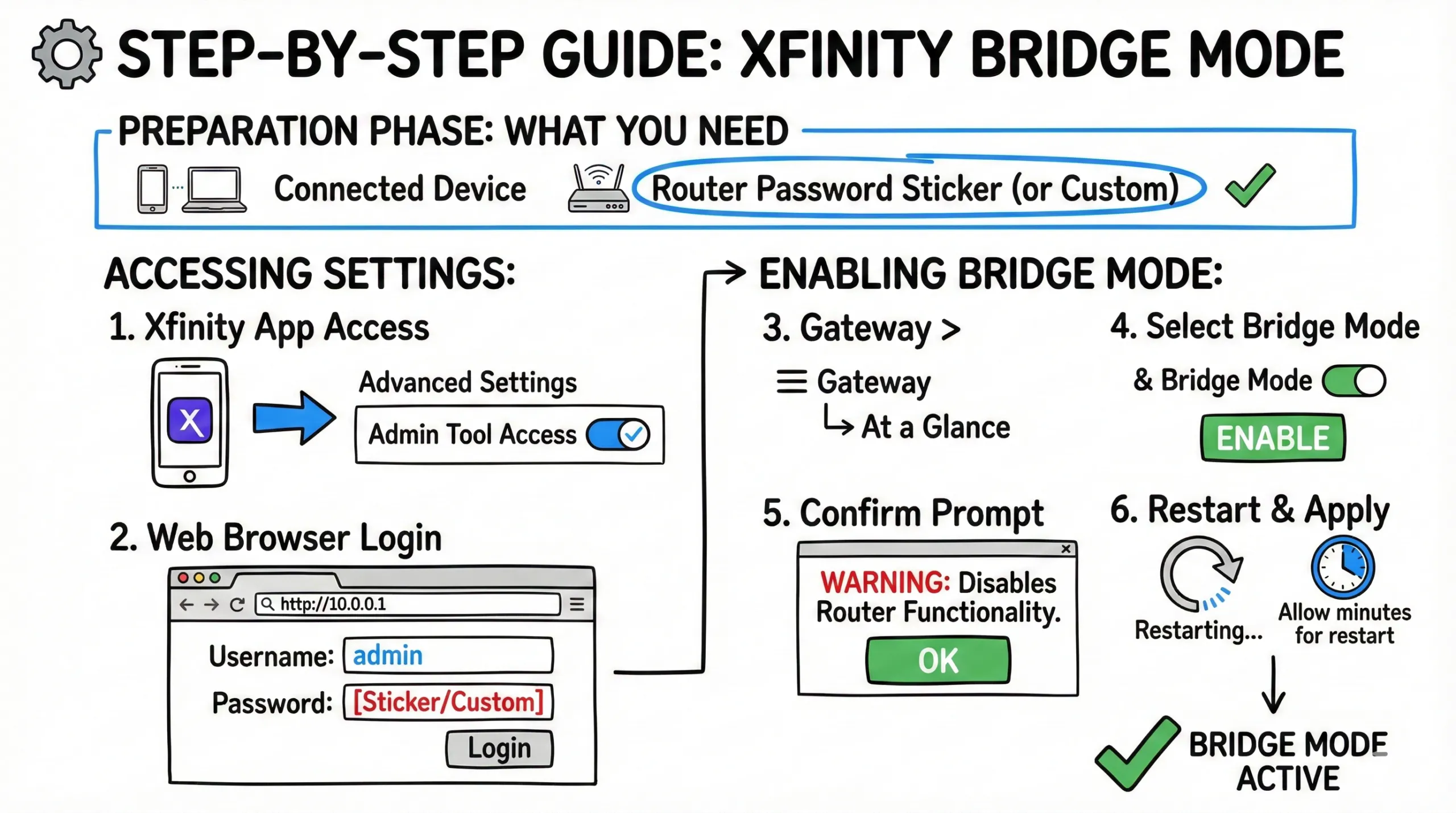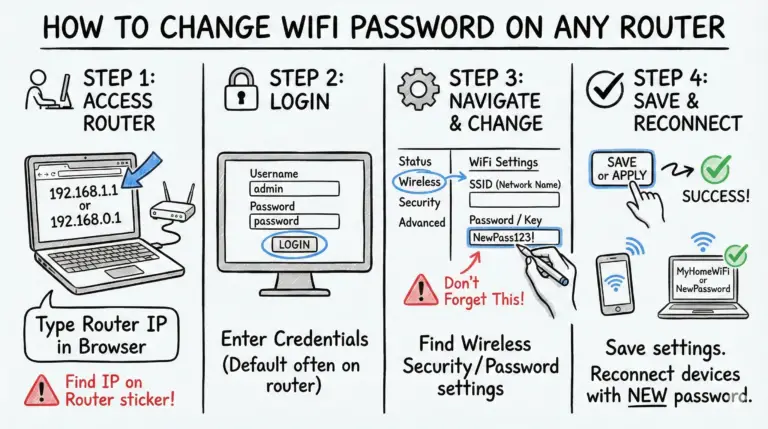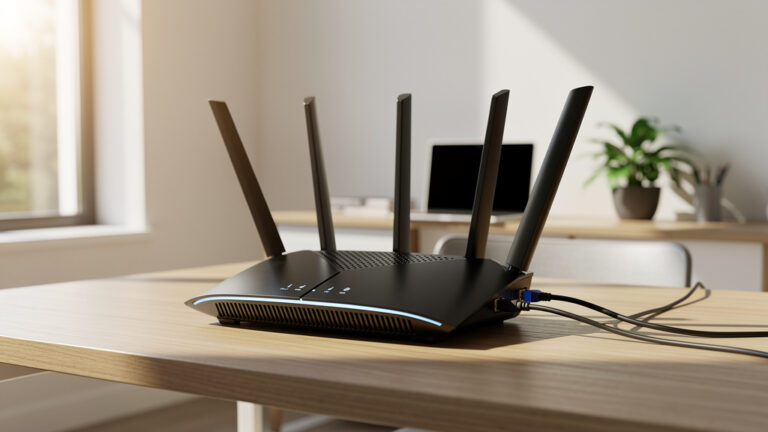Xfinity Bridge Mode feature allows you to turn your Xfinity router-modem combo device into just a modem, eliminating the routing capabilities while still maintaining the modem’s functionality.
Xfinity bridge mode feature can be incredibly useful in certain situations, such as when you want to use your own router or when you need to create a more advanced network setup. It also helps fix double NAT and UPnP conflicts when gaming or running services that require port forwarding.
Key Takeaways
- 🧮 Xfinity Bridge Mode turns your Xfinity router‑modem combo into solely a modem, disabling routing/NAT/Wi‑Fi while keeping DOCSIS connectivity active.
- 🧷 Ideal for using a dedicated router/firewall and avoiding double NAT; connect an Ethernet cable from a gateway LAN port to your router/firewall WAN/Internet port.
- 🖧 Current steps: first allow Admin Tool access in the Xfinity app, then visit
http://10.0.0.1> Gateway > At a Glance to toggle Bridge Mode. - 🧪 Troubleshooting includes validating Ethernet links, confirming the one-device limit on the bridged gateway, and re-enabling Admin Tool access in the app if
10.0.0.1is unreachable. - 🎮 Works with gaming consoles and smart home devices by removing double NAT; actual latency and throughput depend on your provisioned tier, RF signal quality, and router hardware.
- ⚖️ Benefits include flexibility with third‑party routers, better feature control, and custom configurations; drawbacks include extra setup steps and loss of built‑in Xfinity gateway features.
- 🛡️ Note: xFi Advanced Security and WiFi Boost/Pods are disabled in Bridge Mode; you must handle firewalling and security on your own router.
- 📡 Bridge Mode helps resolve NAT type and UPnP conflicts for online gaming and self‑hosted services; it does not change your subscribed bandwidth cap.
- 📶 If Wi‑Fi SSIDs from the gateway disappear after bridging, that’s expected. Some gateways may keep the Xfinity WiFi Home Hotspot active—disable that separately if needed.
- ♻️ If you enable Bridge Mode by mistake, disable it via
http://10.0.0.1after allowing Admin Tool access in the app; a factory reset also restores router mode. - ⏳ Allow several minutes for the gateway to reboot when switching Bridge Mode on or off, and remember only one downstream device can be connected via Ethernet while bridged.
What is Xfinity Bridge Mode?
Xfinity’s Bridge Mode is a unique feature that transforms your Xfinity gateway (the router which comes with Xfinity Internet connection) into a standalone modem. It achieves this by disabling the router capabilities, allowing it to focus on delivering an internet connection from the source to another networking device like your personal router. In Bridge Mode, the gateway passes the public IP to your router and does not provide Wi‑Fi or routing features.
Why use Xfinity Bridge Mode?
There are several reasons why you might want to use Xfinity Bridge Mode:
- Own router preference: If you prefer to use your own router instead of the one provided by Xfinity, enabling Bridge Mode allows you to connect your router directly to the modem and use it as the primary network management device.
- Advanced networking capabilities: Using Bridge Mode gives you more flexibility in customizing your network settings and taking advantage of advanced capabilities offered by your own router. This can include implementing QoS controls, setting up a VPN, creating VLANs, configuring port forwarding and dynamic DNS for hosting services, and enabling parental controls on your router.
- Compatibility with specific devices: Some devices work best behind a single router. Enabling Bridge Mode helps avoid double NAT and UPnP conflicts for consoles, streaming devices, and servers.
How to Enable Xfinity Bridge Mode?
If you’re an Xfinity internet customer and want to use your own router instead of the xFi gateway, enabling bridge mode is a great option. Here is a step-by-step guide to enabling bridge mode on your Xfinity router:

- Accessing the Xfinity router settings:
- Open the Xfinity app on a device connected to your Xfinity network and allow Admin Tool online access in Advanced settings.
- Open a web browser and go to http://10.0.0.1 to access the Xfinity router Admin Tool.
- Enter the username admin and the password printed on your gateway’s sticker (or the custom admin password you previously set).

- Enabling Bridge Mode:
- In the left-hand column of the Admin Tool, select Gateway.
- Click At a Glance.
- Select Bridge Mode and click Enable. Confirm the prompt.

- A message will pop up, confirming that enabling bridge mode will disable the router functionality. Click “OK” to confirm.
- Allow several minutes for the gateway to restart and apply Bridge Mode.
By following these steps, you can easily enable bridge mode on your Xfinity router and use your own router to manage your home network. Remember to consult with Xfinity support if you experience any issues during the process.
Still fulfilling its role as a modem but leaving all routing responsibilities aside.
The operation does not end here! After enabling bridge mode on your Xfinity device, connect an Ethernet cable from a gateway LAN port to your router’s WAN/Internet port and configure your router properly. While in Bridge Mode, only one device should be connected via Ethernet to the gateway.
The external router now manages tasks like assigning IP addresses and maintaining NAT (Network Address Translation). It controls internet access for all connected devices in tandem with the Xfinity modem, which still provides internet service while operating in Bridge Mode.
Choosing the right router for your Xfinity service can significantly impact your overall internet experience. Check out our post on the ‘Best Router for Xfinity‘ for some excellent recommendations.
Benefits and drawbacks of Xfinity Bridge Mode
Bridge mode on Xfinity has its share of advantages and disadvantages. Let’s delve into them:
| Benefits | Drawbacks |
|---|---|
| Flexibility: You can choose a third-party router that meets your specific needs, such as improved Wi‑Fi coverage or advanced features such as superior QoS, security and customization. | Complexity: Setting up Xfinity Bridge Mode and configuring your own router may require more technical knowledge. |
| Compatibility: Xfinity Bridge Mode allows you to use routers from different manufacturers, giving you more options. | Feature limitations: xFi Advanced Security and WiFi Boost/Pods aren’t available while in Bridge Mode. |
| Control: You have more control over your network settings and can customize them to your preferences. Configure network settings like Wi‑Fi and port forwarding as per your needs. | Support: If you encounter any network issues, you may need to troubleshoot them on your own or seek assistance from the router manufacturer. |
| Expand Your Network: Add more access points, switches and wired connections on your own router. | One-device limit: Only one Ethernet device should be connected to the bridged gateway; connect everything else to your router. |
| Cleaner routing: Helps avoid double NAT and UPnP conflicts for gaming and hosting services. | No speed boost: Bridge Mode does not increase your subscribed internet speeds or guarantee lower latency. |
These pros and cons offer a clear picture of what to expect when enabling bridge mode on your Xfinity router. It is crucial to weigh these factors depending on your individual networking needs.
Xfinity Bridge Mode vs. Router Mode
When it comes to setting up your Xfinity internet connection, you have two main options: Xfinity Bridge Mode and Router Mode. Understanding the differences between these modes can help you make an informed decision about which one is right for you.
Differences between Xfinity Bridge Mode and Router Mode
Xfinity Bridge Mode:
- In this mode, the Xfinity gateway acts as a modem only, disabling its routing functionality.
- You can use your own third-party router to manage your home network.
- The Xfinity gateway serves as a pass-through device, forwarding all traffic to your router.
- It helps prevent double NAT and UPnP conflicts for services that need open ports.
Router Mode:
- In this mode, the Xfinity gateway acts as both a modem and a router.
- It provides basic routing capabilities, including DHCP and NAT services.
- You can connect your devices directly to the Xfinity gateway and use its built-in Wi‑Fi.
Security Considerations in Xfinity Bridge Mode
When using Xfinity Bridge Mode, it’s essential to consider the security implications of this setup. While bridge mode can provide benefits such as improved control and compatibility, certain Xfinity features are unavailable in this mode. xFi Advanced Security and WiFi Boost/Pods do not work while the gateway is bridged. In addition, the Xfinity WiFi Home Hotspot may remain enabled unless you turn it off separately. Manage protection on your own router and review the following tips.
Is Xfinity Bridge Mode secure?
While Xfinity Bridge Mode itself does not provide additional security features, it can be generally considered secure as long as proper precautions are taken. However, it’s important to note that certain Xfinity features may be disabled in bridge mode. Here are a few tips to enhance the security of your network in Xfinity Bridge Mode:
Tips for securing your network in Xfinity Bridge Mode
- Enable firewall settings: Make sure to activate the firewall on your router for an additional layer of protection against unauthorized access.
- Regularly update firmware: Keep your router’s firmware up to date to ensure you have the latest security patches and bug fixes.
- Strong passwords: Choose unique and complex passwords for both your router and wireless network to prevent unauthorized access.
- Disable remote management: Disable remote management on your router to prevent outside access and potential security risks.
- Use secure Wi‑Fi encryption: Enable WPA2 or WPA3 encryption protocols on your wireless network to ensure secure communication.
Remember, while Xfinity Bridge Mode can enhance your network control and flexibility, it’s crucial to take steps to secure your network and protect your devices and data.
Compatibility of Xfinity Bridge Mode with Other Devices
When it comes to using Xfinity Bridge Mode, compatibility with different devices is crucial. Here’s a look at how it works with gaming consoles and smart home devices:
Xfinity Bridge Mode and gaming consoles
Gaming consoles such as Xbox and PlayStation require a stable internet connection for online gaming. Xfinity Bridge Mode works with gaming consoles by allowing you to connect your console through your own router and by eliminating double NAT/UPnP conflicts. Actual ping and throughput depend on your internet plan, signal levels, and router quality.
Xfinity Bridge Mode and smart home devices
Smart home devices, such as smart lights, thermostats, and security systems, rely on a stable internet connection for remote access and control. Xfinity Bridge Mode works with smart home devices via your own router. Configure your router’s 2.4 GHz/5 GHz settings and security options to match device requirements.
Troubleshooting Xfinity Bridge Mode
If you encounter any issues with Xfinity Bridge Mode, there are a few common troubleshooting steps you can take to resolve them.
Xfinity bridge mode No internet connectivity
If you’re experiencing a lack of internet connectivity when using Xfinity Bridge Mode, there are a few troubleshooting steps you can take.
- Check Your Connections: Ensure the coaxial cable, power, and the Ethernet from a gateway LAN port to your router’s WAN port are secure. Only one device should be connected to the bridged gateway via Ethernet.
- Check Your Secondary Router: Confirm the WAN/Internet port is set to obtain an IP automatically (DHCP). After enabling Bridge Mode, wait for the WAN to receive a new lease; you may need to reboot the router.
- Reboot Your Xfinity Gateway: Power-cycle the gateway and wait several minutes for all lights to stabilize.
- Re-enable Admin Tool Access: If you can’t reach 10.0.0.1, open the Xfinity app and allow Admin Tool online access again, then try the Admin Tool.
- Disable and Re-enable Bridge Mode: Use 10.0.0.1 > Gateway > At a Glance to toggle Bridge Mode after allowing Admin Tool access in the app. Restart the gateway when prompted.
- Factory Reset Your Xfinity Gateway: If all else fails, press and hold the reset button for about 15 seconds. This restores router mode and turns Wi‑Fi back on; you’ll need to reconfigure your settings.
- Contact Xfinity Support: If you’re still having trouble, contact Xfinity Support for assistance.
Remember, enabling Bridge Mode will turn off the Wi‑Fi of your Xfinity gateway, so ensure you have another router to connect to the internet. The Xfinity WiFi Home Hotspot may need to be disabled separately.
Check out wifi connected but no internet connectivity article for more details.
Accidentally enabling bridge mode
If you accidentally enable bridge mode on your Xfinity wireless gateway, it can cause issues with your internet connectivity. This is because bridge mode disables the routing capabilities of the gateway, which can disrupt the normal flow of data between devices in your home network.
To fix this problem, you may need to troubleshoot by accessing the Admin Tool of your Xfinity router and disabling bridge mode. See the next point on how to turn off bridge mode.
Turning off bridge mode
To turn off bridge mode on your Xfinity wireless gateway, you can press and hold the reset button located on the back of the gateway for about 10–15 seconds to restore router mode. Or, allow Admin Tool access in the Xfinity app and use Gateway > At a Glance in the Admin Tool at 10.0.0.1 to disable Bridge Mode.
If you’re unable to find the option, navigate to Gateway > At a Glance in your router’s settings and follow the instructions provided to disable it.
Don’t worry if you encounter any issues along the way — troubleshooting steps are available to help resolve any problems with Xfinity bridge mode not working as expected.
Features Not Working
Parental controls and port forwarding require the gateway’s routing functions. In Bridge Mode, use your own router for these features. xFi Advanced Security and WiFi Boost/Pods are not available when Bridge Mode is enabled.
Slow Speeds
Try changing cables, router channels or switching to 5 GHz Wi‑Fi. Bridge Mode does not increase your subscribed speed. Contact Xfinity if issues persist.
If you’re switching modems or returning your old device, our guide on how to return Xfinity equipment can help you navigate the process.
Conclusion
In conclusion, Xfinity Bridge Mode is a useful feature for those who want to use their own router while still utilizing the Xfinity gateway for its modem capabilities. By enabling Bridge Mode, users can disable the routing functionalities of the Xfinity gateway and avoid conflicts like double NAT. This allows for more control over the network and the ability to use third-party routers for improved customization.
Some key points to consider before enabling Xfinity Bridge Mode include ensuring proper connections between routers (gateway LAN to router WAN), the one-device Ethernet limit on the bridged gateway, configuring IP address ranges on your router, and checking for any misconfigurations in the router settings. Bridge Mode does not change the maximum internet speed of your plan, but it can simplify routing and port management.
Overall, Xfinity Bridge Mode is a useful feature for optimizing your home network setup and enhancing your online experience.
Can Data Roaming Affect Xfinity Bridge Mode?
Data roaming explained: Data roaming typically refers to the ability to use mobile data services while traveling outside of your home network. However, it is not directly related to Xfinity Bridge Mode. The Bridge Mode is a feature that allows you to connect multiple devices to your Xfinity network. While data roaming might affect your overall data usage, it does not specifically impact the functionality of the Bridge Mode.
Frequently Asked Questions – FAQs
How do I enable or disable Bridge Mode on my Xfinity gateway?
To enable or disable Bridge Mode on your Xfinity gateway, first allow Admin Tool access in the Xfinity app. Then connect to http://10.0.0.1 in a web browser and sign in to the Admin Tool. Go to Gateway > At a Glance and use the Bridge Mode toggle. The gateway will restart and apply the change.
Why would I want to use Bridge Mode with my own router?
Using Bridge Mode with your own router gives you more control over your home network setup and helps avoid double NAT and UPnP conflicts. It allows you to customize and optimize your Wi‑Fi network according to your specific needs and preferences.
Are there any drawbacks or considerations when using Bridge Mode?
Bridge Mode requires some configuration and disables certain Xfinity gateway features. xFi Advanced Security and WiFi Boost/Pods are not available while bridged, and the gateway supports only one Ethernet device in this mode.
Which port is bridge mode on xfinity gateway?
When you enable bridge mode on an Xfinity Gateway, it functions only as a modem. Connect your separate router using an Ethernet cable from any gateway LAN port to your router’s WAN/Internet port. Only one device should be connected to the gateway via Ethernet while bridged.
However, it’s important to note that the specific setup can vary depending on the model of your Xfinity Gateway and the requirements of your separate router. Always refer to the user manuals or support resources for your specific devices if you’re unsure.
- 10 Best Network Switches for Home Networks in 2026 (Top Picks) - December 24, 2025
- 7 Best Budget Routers For Small Business Networks (Under $200) - December 22, 2025
- How to Configure a Secure Site-to-Site VPN on Cisco Firepower Complete Guide - December 3, 2025




